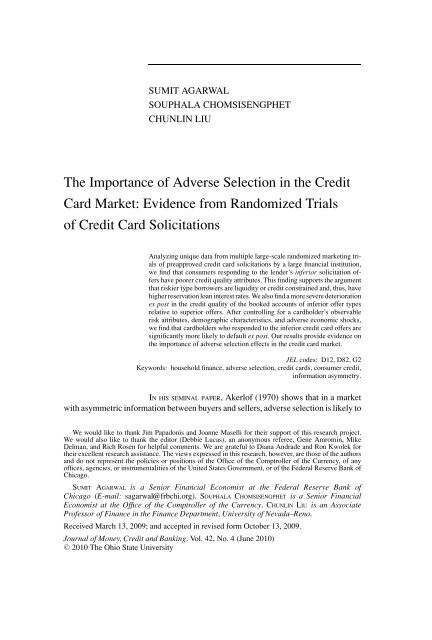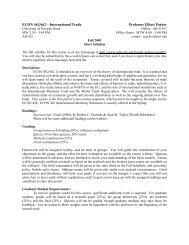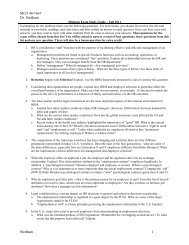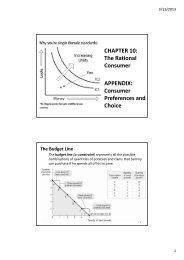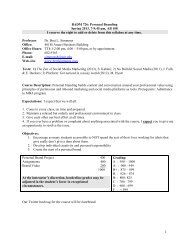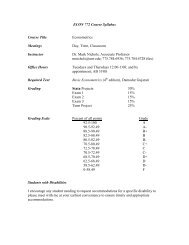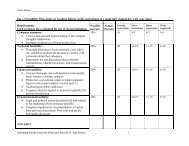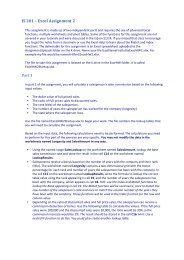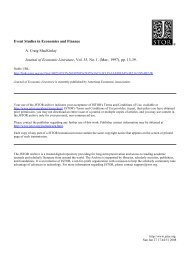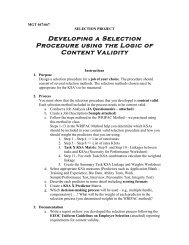The Importance of Adverse Selection in the Credit Card Market ...
The Importance of Adverse Selection in the Credit Card Market ...
The Importance of Adverse Selection in the Credit Card Market ...
You also want an ePaper? Increase the reach of your titles
YUMPU automatically turns print PDFs into web optimized ePapers that Google loves.
SUMIT AGARWAL<br />
SOUPHALA CHOMSISENGPHET<br />
CHUNLIN LIU<br />
<strong>The</strong> <strong>Importance</strong> <strong>of</strong> <strong>Adverse</strong> <strong>Selection</strong> <strong>in</strong> <strong>the</strong> <strong>Credit</strong><br />
<strong>Card</strong> <strong>Market</strong>: Evidence from Randomized Trials<br />
<strong>of</strong> <strong>Credit</strong> <strong>Card</strong> Solicitations<br />
Analyz<strong>in</strong>g unique data from multiple large-scale randomized market<strong>in</strong>g trials<br />
<strong>of</strong> preapproved credit card solicitations by a large f<strong>in</strong>ancial <strong>in</strong>stitution,<br />
we f<strong>in</strong>d that consumers respond<strong>in</strong>g to <strong>the</strong> lender’s <strong>in</strong>ferior solicitation <strong>of</strong>fers<br />
have poorer credit quality attributes. This f<strong>in</strong>d<strong>in</strong>g supports <strong>the</strong> argument<br />
that riskier type borrowers are liquidity or credit constra<strong>in</strong>ed and, thus, have<br />
higher reservation loan <strong>in</strong>terest rates. We also f<strong>in</strong>d a more severe deterioration<br />
ex post <strong>in</strong> <strong>the</strong> credit quality <strong>of</strong> <strong>the</strong> booked accounts <strong>of</strong> <strong>in</strong>ferior <strong>of</strong>fer types<br />
relative to superior <strong>of</strong>fers. After controll<strong>in</strong>g for a cardholder’s observable<br />
risk attributes, demographic characteristics, and adverse economic shocks,<br />
we f<strong>in</strong>d that cardholders who responded to <strong>the</strong> <strong>in</strong>ferior credit card <strong>of</strong>fers are<br />
significantly more likely to default ex post. Our results provide evidence on<br />
<strong>the</strong> importance <strong>of</strong> adverse selection effects <strong>in</strong> <strong>the</strong> credit card market.<br />
JEL codes: D12, D82, G2<br />
Keywords: household f<strong>in</strong>ance, adverse selection, credit cards, consumer credit,<br />
<strong>in</strong>formation asymmetry.<br />
IN HIS SEMINAL PAPER, Akerl<strong>of</strong> (1970) shows that <strong>in</strong> a market<br />
with asymmetric <strong>in</strong>formation between buyers and sellers, adverse selection is likely to<br />
We would like to thank Jim Papadonis and Joanne Maselli for <strong>the</strong>ir support <strong>of</strong> this research project.<br />
We would also like to thank <strong>the</strong> editor (Debbie Lucas), an anonymous referee, Gene Amrom<strong>in</strong>, Mike<br />
Delman, and Rich Rosen for helpful comments. We are grateful to Diana Andrade and Ron Kwolek for<br />
<strong>the</strong>ir excellent research assistance. <strong>The</strong> views expressed <strong>in</strong> this research, however, are those <strong>of</strong> <strong>the</strong> authors<br />
and do not represent <strong>the</strong> policies or positions <strong>of</strong> <strong>the</strong> Office <strong>of</strong> <strong>the</strong> Comptroller <strong>of</strong> <strong>the</strong> Currency, <strong>of</strong> any<br />
<strong>of</strong>fices, agencies, or <strong>in</strong>strumentalities <strong>of</strong> <strong>the</strong> United States Government, or <strong>of</strong> <strong>the</strong> Federal Reserve Bank <strong>of</strong><br />
Chicago.<br />
SUMIT AGARWAL is a Senior F<strong>in</strong>ancial Economist at <strong>the</strong> Federal Reserve Bank <strong>of</strong><br />
Chicago (E-mail: sagarwal@frbchi.org). SOUPHALA CHOMSISENGPHET is a Senior F<strong>in</strong>ancial<br />
Economist at <strong>the</strong> Office <strong>of</strong> <strong>the</strong> Comptroller <strong>of</strong> <strong>the</strong> Currency. CHUNLIN LIU is an Associate<br />
Pr<strong>of</strong>essor <strong>of</strong> F<strong>in</strong>ance <strong>in</strong> <strong>the</strong> F<strong>in</strong>ance Department, University <strong>of</strong> Nevada–Reno.<br />
Received March 13, 2009; and accepted <strong>in</strong> revised form October 13, 2009.<br />
Journal <strong>of</strong> Money, <strong>Credit</strong> and Bank<strong>in</strong>g, Vol. 42, No. 4 (June 2010)<br />
C○ 2010 <strong>The</strong> Ohio State University
744 : MONEY, CREDIT AND BANKING<br />
result. Over <strong>the</strong> years, numerous papers have extended Akerl<strong>of</strong>’s <strong>the</strong>ory. For example,<br />
Stiglitz and Weiss (1981) show how asymmetric <strong>in</strong>formation can prevent a credit<br />
market from clear<strong>in</strong>g and lead to <strong>the</strong> ration<strong>in</strong>g <strong>of</strong> credit. Bester (1985) shows that<br />
endogenously chosen collateral may <strong>of</strong>fset <strong>the</strong> problem <strong>of</strong> <strong>in</strong>formation asymmetry and<br />
<strong>the</strong> market can clear. Empirical evidence <strong>of</strong> asymmetric <strong>in</strong>formation <strong>in</strong> <strong>the</strong> consumer<br />
credit markets <strong>in</strong>cludes: 1 credit cards (Ausubel 1999), home mortgage and automobile<br />
loans (Edelberg 2003), home equity credit (Agarwal et al. 2006), subprime automobile<br />
loans (Adams, E<strong>in</strong>av, and Lev<strong>in</strong> 2009), and personal loans (Karlan and Z<strong>in</strong>man 2009).<br />
In this paper, we test for adverse selection <strong>in</strong> <strong>the</strong> credit market us<strong>in</strong>g unique data<br />
from multiple large-scale randomized market<strong>in</strong>g trials <strong>of</strong> preapproved credit card<br />
solicitations by a large f<strong>in</strong>ancial <strong>in</strong>stitution that issues credit cards nationally. Our<br />
paper is closely related to Ausubel (1999) who also <strong>in</strong>vestigates <strong>the</strong> importance <strong>of</strong><br />
adverse selection <strong>in</strong> <strong>the</strong> credit card market. However, we provide additional evidence<br />
by focus<strong>in</strong>g on <strong>the</strong> credit market toward low-risk “prime” borrowers (population). If<br />
adverse selection is present <strong>in</strong> a population with relatively good credit quality, we<br />
should expect that <strong>the</strong> adverse selection effects could have been even stronger had<br />
<strong>the</strong> lender reached out to a lower credit quality population. Hence, our study can be<br />
considered as a m<strong>in</strong>imal test <strong>of</strong> <strong>the</strong> importance <strong>of</strong> adverse selection <strong>in</strong> <strong>the</strong> credit card<br />
market.<br />
To preview our results, we f<strong>in</strong>d that consumers who responded to <strong>the</strong> lender’s<br />
credit card solicitation exhibit significantly higher credit risk attributes than those<br />
who did not respond. When we compare <strong>the</strong> credit risk characteristics <strong>of</strong> responders<br />
across contract <strong>of</strong>fer types with<strong>in</strong> a market<strong>in</strong>g trial, we f<strong>in</strong>d that consumers who<br />
responded to <strong>the</strong> <strong>in</strong>ferior <strong>of</strong>fer types (e.g., higher APR <strong>of</strong>fer) exhibit poorer credit<br />
quality characteristics than those respond<strong>in</strong>g to superior <strong>of</strong>fer types. <strong>The</strong>se patterns<br />
are quite strik<strong>in</strong>g and support <strong>the</strong> argument that higher risk consumers, assum<strong>in</strong>g that<br />
consumers are aware <strong>of</strong> <strong>the</strong>ir own credit risk type, have fewer options for acquir<strong>in</strong>g<br />
funds to smooth consumption (i.e., <strong>the</strong>y are liquidity or credit constra<strong>in</strong>ed). And<br />
<strong>the</strong>refore, <strong>the</strong>y have a higher reservation credit card <strong>in</strong>terest rate. Taken toge<strong>the</strong>r,<br />
<strong>the</strong>se observations provide prelim<strong>in</strong>ary evidence that <strong>the</strong> lender may be susceptible<br />
to potential adverse selection problems.<br />
We f<strong>in</strong>d that <strong>the</strong> credit quality <strong>of</strong> <strong>the</strong> booked accounts <strong>of</strong> <strong>in</strong>ferior <strong>of</strong>fer types more<br />
severely deteriorates ex post relative to that <strong>of</strong> superior <strong>of</strong>fers. Moreover, we also f<strong>in</strong>d<br />
that for unobservable reasons, cardholders who responded to <strong>the</strong> <strong>in</strong>ferior credit card<br />
<strong>of</strong>fers are significantly more likely to default ex post. Overall, our results provide<br />
evidence on <strong>the</strong> existence <strong>of</strong> adverse selection <strong>in</strong> <strong>the</strong> credit card market.<br />
<strong>The</strong> paper proceeds as follows. Section 1 describes <strong>the</strong> market experiments and<br />
data. Section 2 compares <strong>the</strong> observable risk characteristics <strong>of</strong> responders to those <strong>of</strong><br />
nonresponders and <strong>the</strong>n compares <strong>the</strong> responder’s risk type across credit card <strong>of</strong>fers.<br />
1. Numerous studies have tested for <strong>the</strong> role <strong>of</strong> asymmetric <strong>in</strong>formation <strong>in</strong> <strong>the</strong> auto and health <strong>in</strong>surance<br />
markets. For example, Genesove (1993) analyzes <strong>the</strong> market for used cars and f<strong>in</strong>ds weak evidence for<br />
adverse selection, while Chiappori and Salanie (2000) exam<strong>in</strong>e <strong>the</strong> French market for automobile <strong>in</strong>surance<br />
and f<strong>in</strong>d no evidence <strong>of</strong> adverse selection. Altman, Cutler, and Zeckhauser (1998) study <strong>the</strong> health <strong>in</strong>surance<br />
market and f<strong>in</strong>d evidence <strong>of</strong> adverse selection.
SUMIT AGARWAL, SOUPHALA CHOMSISENGPHET, AND CHUNLIN LIU : 745<br />
F<strong>in</strong>ally, we test for adverse selection <strong>in</strong> Section 3 and provide conclud<strong>in</strong>g remarks <strong>in</strong><br />
Section 4.<br />
1. EXPERIMENT DESIGN AND DATA DESCRIPTION<br />
Our data come from a large f<strong>in</strong>ancial <strong>in</strong>stitution that issues credit cards nationally.<br />
As part <strong>of</strong> rout<strong>in</strong>e market<strong>in</strong>g campaigns between January and May 2001, <strong>the</strong> lender<br />
conducted several large-scale randomized trials <strong>of</strong> preapproved credit card solicitations<br />
by mail<strong>in</strong>g out seven dist<strong>in</strong>ct solicitation <strong>of</strong>fers under three different market<strong>in</strong>g<br />
trials to a large random population <strong>of</strong> over 2.3 million consumers. <strong>The</strong> lender generated<br />
<strong>the</strong> mail<strong>in</strong>g list by target<strong>in</strong>g <strong>the</strong> prime borrowers who have relatively good FICO<br />
scores. In order to conduct <strong>the</strong> trial, <strong>the</strong> lender purchased extensive credit bureau<br />
<strong>in</strong>formation (<strong>in</strong>clud<strong>in</strong>g FICO scores) for <strong>the</strong> entire mail<strong>in</strong>g list <strong>of</strong> consumers.<br />
<strong>The</strong> first market<strong>in</strong>g trial, A, had three <strong>of</strong>fers. <strong>The</strong> first <strong>of</strong>fer, A1, was 0% <strong>in</strong>terest<br />
on purchases for <strong>the</strong> first 8 months with a subsequent or “go-to” rate <strong>of</strong> 9.99%. <strong>The</strong><br />
second <strong>of</strong>fer, A2, was 0% <strong>in</strong>terest on purchases for <strong>the</strong> first 12 months with a go-to<br />
rate <strong>of</strong> 9.99%. F<strong>in</strong>ally, <strong>the</strong> third <strong>of</strong>fer, A3, was 0% <strong>in</strong>terest on purchases for <strong>the</strong> first 8<br />
months with a go-to rate <strong>of</strong> 8.99%. All three <strong>of</strong>fers required a balance transfer (BT; no<br />
m<strong>in</strong>imum amount required), and <strong>the</strong> <strong>in</strong>terest rate on <strong>the</strong> BT was <strong>the</strong> go-to rate. Both<br />
<strong>of</strong>fers A2 and A3 are clearly superior <strong>of</strong>fers to A1 because (i) borrowers can have<br />
four additional months <strong>of</strong> 0% APR on purchases under A2, and (ii) borrowers will<br />
face a 100 basis po<strong>in</strong>t lower go-to rate after 8 months under A3. It is not possible to<br />
determ<strong>in</strong>e whe<strong>the</strong>r <strong>of</strong>fer A2 is superior/<strong>in</strong>ferior to <strong>of</strong>fer A3 because both <strong>the</strong> duration<br />
for <strong>the</strong> 0% purchase and <strong>the</strong> go-to rates are different. So for our purposes, we will<br />
only compare <strong>of</strong>fer A1 to <strong>of</strong>fer A2 and <strong>of</strong>fer A1 to <strong>of</strong>fer A3.<br />
<strong>The</strong> second market<strong>in</strong>g trial, B, had two <strong>of</strong>fers. <strong>The</strong> first <strong>of</strong>fer, B1, provided a<br />
fixed 9.99% <strong>in</strong>terest on purchases and balance transfer for life. <strong>The</strong> second <strong>of</strong>fer, B2,<br />
provided a fixed 8.99% <strong>in</strong>terest on purchases and balance transfer for life. In this<br />
case, <strong>of</strong>fer B2 is clearly superior to <strong>of</strong>fer B1 because it carries a 100 basis po<strong>in</strong>t lower<br />
<strong>in</strong>terest rate. F<strong>in</strong>ally, <strong>the</strong> third market<strong>in</strong>g trial, C, had two <strong>of</strong>fers. <strong>The</strong> first <strong>of</strong>fer, C1,<br />
provides a 0% <strong>in</strong>terest on purchases, balance transfers, and cash advances for <strong>the</strong> first<br />
6 months with a go-to rate <strong>of</strong> 14.99%. <strong>The</strong> second <strong>of</strong>fer, C2, provides a 0% <strong>in</strong>terest<br />
on purchases, balance transfers, and cash advances for <strong>the</strong> first 6 months with a go-to<br />
rate <strong>of</strong> 12.99%. Offer C2 is superior to <strong>of</strong>fer C1 because its go-to rate is 200 basis<br />
po<strong>in</strong>ts lower.<br />
As previously mentioned, <strong>the</strong> bank mailed out 2.3 million solicitation <strong>of</strong>fers over<br />
a 5-month period (January to May 2001) under <strong>the</strong> three market<strong>in</strong>g trials. By July<br />
2001, a total <strong>of</strong> 6,448 (0.28%) consumers had responded to <strong>the</strong> solicitations. Of <strong>the</strong>se<br />
respondents, <strong>the</strong> bank rejected 1,389 (21.5%) applications due to deterioration <strong>in</strong><br />
credit risk characteristics <strong>of</strong> <strong>the</strong> consumer and issued a credit card to 5,059 consumers.<br />
For <strong>the</strong>se booked accounts, we are able to track <strong>the</strong> debt repayment patterns <strong>of</strong> each
746 : MONEY, CREDIT AND BANKING<br />
cardholder over <strong>the</strong> next 24-month period (until July 2003) after <strong>the</strong> lender issued <strong>the</strong><br />
credit card.<br />
In addition to captur<strong>in</strong>g <strong>the</strong> ex post default behaviors <strong>of</strong> <strong>the</strong> cardholders, our data<br />
<strong>in</strong>clude two additional key pieces <strong>of</strong> <strong>in</strong>formation: a cardholder’s updated FICO credit<br />
score and <strong>in</strong>ternal payment behavior score. A credit score, whe<strong>the</strong>r a generic FICO<br />
score or an <strong>in</strong>ternal behavior score, is an <strong>in</strong>dex constructed to evaluate an <strong>in</strong>dividual’s<br />
relative risk <strong>of</strong> default conditional on his/her credit pr<strong>of</strong>ile. For example, a lower FICO<br />
score implies a higher probability <strong>of</strong> a consumer default<strong>in</strong>g on his outstand<strong>in</strong>g debt <strong>in</strong><br />
<strong>the</strong> next 24 months. <strong>The</strong> credit card lender <strong>in</strong> our study obta<strong>in</strong>ed an applicant’s external<br />
credit risk (FICO) score at <strong>the</strong> time <strong>of</strong> solicitation and <strong>the</strong>n updated <strong>the</strong> FICO score on a<br />
quarterly basis after credit issuance. In addition, <strong>the</strong> lender also developed an <strong>in</strong>ternal<br />
behavior scor<strong>in</strong>g model to assess <strong>the</strong> likelihood that a credit account will become<br />
del<strong>in</strong>quent <strong>in</strong> <strong>the</strong> near future (e.g., <strong>the</strong> next 6 months). <strong>The</strong> quarterly updated FICO<br />
score captures a consumer’s repayment behavior on all currently open credit trades<br />
and, <strong>the</strong>refore, is <strong>in</strong>formative on <strong>the</strong> extent to which <strong>the</strong> cardholder faced adverse<br />
economic shocks to his/her household portfolio that h<strong>in</strong>dered his/her ability to meet<br />
debt obligations on all outstand<strong>in</strong>g credit. <strong>The</strong> <strong>in</strong>ternal behavior score reveals <strong>the</strong><br />
relative risk type <strong>of</strong> <strong>the</strong> cardholder based on <strong>the</strong> <strong>in</strong>ternal repayment behavior with this<br />
credit card lender. <strong>The</strong>se two risk scores summarize a cardholder’s relative risk type<br />
for <strong>the</strong> lender.<br />
2. OBSERVABLE INFORMATION<br />
Table 1 compares <strong>the</strong> average credit risk characteristics <strong>of</strong>: (i) responders versus<br />
nonresponders for each <strong>of</strong>fer type with<strong>in</strong> a market<strong>in</strong>g trial and (ii) responders across<br />
<strong>of</strong>fer types with<strong>in</strong> a market<strong>in</strong>g trial for six credit bureau variables. Specifically, we<br />
focus on <strong>the</strong> follow<strong>in</strong>g risk attributes: (i) total credit card l<strong>in</strong>e amount (for all credit<br />
cards), (ii) total credit card utilization rate (total credit withdrawn as a fraction <strong>of</strong><br />
total credit availability on all credit cards), (iii) account age (<strong>the</strong> length <strong>of</strong> time <strong>the</strong><br />
customer’s credit file has existed at <strong>the</strong> credit bureau), (iv) del<strong>in</strong>quency behavior<br />
(30+days past due), and (v) FICO score.<br />
2.1 Responders versus Nonresponders<br />
<strong>The</strong> third and fourth columns <strong>of</strong> Table 1 compare <strong>the</strong> number and percentage <strong>of</strong><br />
responders and nonresponders for each <strong>of</strong>fer type <strong>in</strong> a given market<strong>in</strong>g trial. First, <strong>the</strong><br />
results show that <strong>the</strong> lender <strong>of</strong>fered a disproportionately higher percentage <strong>of</strong> <strong>in</strong>ferior<br />
<strong>of</strong>fers with<strong>in</strong> each market<strong>in</strong>g trial (A1, B1, and C1). Of <strong>the</strong> 951,651 solicitations<br />
under market<strong>in</strong>g trial A, for example, <strong>the</strong> lender sent 646,370 (68%) A1 <strong>of</strong>fers to<br />
consumers, but only sent 150,643 (15.8%) A2 <strong>of</strong>fers and 154,548 (16.2%) A3 <strong>of</strong>fers.<br />
Fur<strong>the</strong>rmore, <strong>the</strong> response rate for superior <strong>of</strong>fers (A2, A3, B2, and C2) is higher<br />
than that for <strong>the</strong> <strong>in</strong>ferior <strong>of</strong>fers. Consumers were more than twice as likely to accept<br />
<strong>of</strong>fer A2 as <strong>the</strong>y were to accept <strong>of</strong>fer A1 (0.56% response rate for A2 <strong>of</strong>fer versus<br />
a 0.27% response rate for A1 <strong>of</strong>fer). <strong>The</strong> difference <strong>in</strong> <strong>the</strong> response rate for A1 and
SUMIT AGARWAL, SOUPHALA CHOMSISENGPHET, AND CHUNLIN LIU : 747<br />
TABLE 1<br />
CREDIT RISK CHARACTERISTICS OF RESPONDERS AND NONRESPONDERS<br />
Offer Nonresponders and Response Balance <strong>Credit</strong> l<strong>in</strong>e ($) Utilization (%) Account 30+ DPD FICO<br />
type responders Frequency rate (%) transfer ($) all cards all cards age prior 12 months score<br />
A1 Nonresponders 644,624 0 21,068 8 131 0.08% 773<br />
Responders 1,746 0.27% 1,503 19,557 ∗∗ 13 ∗∗ 83 ∗∗ 0.31% ∗∗ 742 ∗∗<br />
A2 Nonresponders 149,800 0 20,409 9 123 0.04% 772<br />
Responders 843 0.56% 1,926 23,506 ∗∗ 15 ∗∗ 92 ∗∗ 0.12% ∗∗ 744 ∗∗<br />
A3 Nonresponders 154,090 0 22,429 9 137 0.04% 772<br />
Responders 458 0.30% 1,922 22,100 15 ∗∗ 94 ∗∗ 0.15% ∗∗ 744 ∗∗<br />
B1 Nonresponders 542,666 0 21,354 8 132 0.18% 773<br />
Responders 1,058 0.19% 363 15,163 ∗∗ 14 ∗∗ 80 ∗∗ 0.28% ∗∗ 740 ∗∗<br />
B2 Nonresponders 150,118 0 20,369 9 122 0.13% 772<br />
Responders 708 0.47% 538 18,553 ∗∗ 16 ∗∗ 82 ∗∗ 0.10% ∗∗ 742 ∗∗<br />
C1 Nonresponders 493,903 0 21,868 8 135 0.07% 773<br />
Responders 957 0.19% 2,464 27,772 ∗∗ 14 ∗∗ 94 ∗∗ 0.19% ∗∗ 743 ∗∗<br />
C2 Nonresponders 150,076 0 20,400 9 122 0.03% 772<br />
Responders 678 0.45% 3,078 29,479 ∗∗ 17 ∗∗ 98 ∗∗ 0.11% ∗∗ 743 ∗∗<br />
T-test for diff A1 & A2 −3.60 −4.45 −2.60 −2.79 −5.28 −1.24<br />
T-test for diff A1 & A3 −2.87 −2.35 −2.12 −2.62 −3.89 −1.01<br />
T-test for diff B1 & B2 −5.61 −4.05 −2.06 −0.53 −2.77 −1.05<br />
T-test for diff C1 & C2 −3.41 −1.26 −3.32 −0.95 −2.13 0.00<br />
NOTES: Offer A1 has an APR <strong>of</strong> 0% for purchases dur<strong>in</strong>g <strong>the</strong> first 8 months with a balance transfer rate <strong>of</strong> 9.99%, and <strong>the</strong>reafter <strong>the</strong> APR on purchases goes to 9.99%. Offer A2 has an APR <strong>of</strong> 0% for purchases dur<strong>in</strong>g <strong>the</strong><br />
first 12 months with a balance transfer rate <strong>of</strong> 9.99% and <strong>the</strong>reafter <strong>the</strong> APR on purchases goes to 9.99%. Offer A3 has an APR <strong>of</strong> 0% for purchases dur<strong>in</strong>g <strong>the</strong> first 8 months with a balance transfer rate <strong>of</strong> 8.99% and<br />
<strong>the</strong>reafter <strong>the</strong> APR on purchases goes to 8.99%. Offer B1 has no teaser rate <strong>of</strong>fer but <strong>the</strong> APR on purchases and balance transfer are 9.99% for life. Offer B2 has no teaset rate <strong>of</strong>fer but <strong>the</strong> APR on purchases and balance<br />
transfer are 8.99% for life. Offer C1 has an APR <strong>of</strong> 0% on purchases and balance transfer for <strong>the</strong> first 6 months and <strong>the</strong>reafter <strong>the</strong> APR on purchases goes to 14.99%. Offer C2 has an APR <strong>of</strong> 0% on purchases and balance<br />
transfer for <strong>the</strong> first 6 months and <strong>the</strong>reafter <strong>the</strong> APR on purchases goes to 12.99%. ∗∗ Significance at <strong>the</strong> 5% level.
748 : MONEY, CREDIT AND BANKING<br />
A3 <strong>of</strong>fers, however, is <strong>in</strong>significant (0.27% and 0.29%, respectively). This suggests<br />
that consumers for market<strong>in</strong>g trial A are more sensitive to <strong>the</strong> duration <strong>of</strong> <strong>the</strong> teaser<br />
<strong>of</strong>fer than <strong>the</strong> <strong>in</strong>terest rate. Consumers for market<strong>in</strong>g trial B with fixed rate for life on<br />
purchases and balance transfers are more than twice as likely to choose B2 over B1<br />
(response rates <strong>of</strong> 0.47% and 0.19% po<strong>in</strong>ts, respectively, for B2 and B1). Similarly,<br />
consumers for market<strong>in</strong>g trial C are twice as likely to choose C2 over C1 (response<br />
rates <strong>of</strong> 0.44% and 0.19%, respectively, for C2 and C1).<br />
In terms <strong>of</strong> <strong>the</strong>ir credit risk characteristics, responders and nonresponders are strik<strong>in</strong>gly<br />
different. Responders across all product <strong>of</strong>fer<strong>in</strong>gs have significantly lower FICO<br />
scores, by 30 po<strong>in</strong>ts on average, than nonresponders. Look<strong>in</strong>g at more specific credit<br />
risk attributes, responders for <strong>of</strong>fers <strong>in</strong> <strong>the</strong> A and B market<strong>in</strong>g trials, with <strong>the</strong> exception<br />
<strong>of</strong> <strong>of</strong>fer A2, have a higher credit limit on all open and active credit cards than<br />
nonresponders, while responders for <strong>of</strong>fers <strong>in</strong> <strong>the</strong> C market<strong>in</strong>g trial have lower credit<br />
limits than nonresponders. Across all <strong>of</strong>fer types, <strong>the</strong> average credit utilization rate<br />
on all open and active credit cards is higher for responders (about 14% average across<br />
<strong>of</strong>fers) than nonresponders (about 8% across <strong>of</strong>fers). In addition, <strong>the</strong> average length <strong>of</strong><br />
credit history with <strong>the</strong> bureau is 89 months for responders, while that for nonresponders<br />
is 129 months. Responders across all <strong>of</strong>fer types experienced significantly higher<br />
del<strong>in</strong>quency <strong>in</strong>cidences—30+ days past due, <strong>in</strong> <strong>the</strong> 12 months prior to respond<strong>in</strong>g<br />
to <strong>the</strong> lender’s solicitation. F<strong>in</strong>ally, while <strong>the</strong>re is significant variation <strong>in</strong> many <strong>of</strong> <strong>the</strong><br />
observable characteristics, <strong>the</strong> average FICO scores fall with<strong>in</strong> a narrow range. This<br />
is due to <strong>the</strong> fact that <strong>the</strong> lender only requested records for prime borrowers from <strong>the</strong><br />
credit bureau.<br />
2.2 Responders’ Choice on Offer Types<br />
Now we look at <strong>the</strong> risk characteristics <strong>of</strong> <strong>the</strong> responders by <strong>the</strong>ir choice <strong>of</strong> <strong>of</strong>fer<br />
type with<strong>in</strong> each market<strong>in</strong>g trial. <strong>The</strong> first market trial, A, has three <strong>of</strong>fer types—A1,<br />
A2, and A3. As previously mentioned, <strong>of</strong>fers A2 and A3 are clearly superior to A1, but<br />
it is unclear whe<strong>the</strong>r A2 or A3 is <strong>the</strong> superior <strong>of</strong>fer among those two. <strong>The</strong> results show<br />
a statistically <strong>in</strong>significant difference <strong>in</strong> FICO score between responders choos<strong>in</strong>g <strong>the</strong><br />
<strong>in</strong>ferior <strong>of</strong>fer A1 relative to <strong>the</strong> superior <strong>of</strong>fer A2 (average scores <strong>of</strong> 742 and 744,<br />
respectively) or <strong>in</strong> FICO score between responders choos<strong>in</strong>g <strong>the</strong> <strong>in</strong>ferior <strong>of</strong>fer A1 and<br />
<strong>the</strong> superior <strong>of</strong>fer A3 (average score <strong>of</strong> 742 and 744, respectively). On <strong>the</strong> o<strong>the</strong>r hand,<br />
o<strong>the</strong>r risk measures show that responders to <strong>the</strong> <strong>in</strong>ferior <strong>of</strong>fer A1 may be more credit<br />
or liquidity constra<strong>in</strong>ed, or riskier than responders to <strong>the</strong> superior <strong>of</strong>fers A2 and A3.<br />
For <strong>in</strong>stance, responders to <strong>the</strong> <strong>in</strong>ferior <strong>of</strong>fer A1 have on average a significantly lower<br />
credit l<strong>in</strong>e available on all open and active credit cards than those to <strong>the</strong> superior<br />
<strong>of</strong>fers A2 and A3. Moreover, <strong>the</strong> percentage <strong>of</strong> prior 12-month del<strong>in</strong>quency among<br />
<strong>the</strong> <strong>in</strong>ferior <strong>of</strong>fer A1 responders is significantly higher than that <strong>of</strong> responders to <strong>the</strong><br />
superior <strong>of</strong>fer.<br />
Similarly, while <strong>the</strong> average FICO scores <strong>of</strong> responders to <strong>the</strong> <strong>in</strong>ferior <strong>of</strong>fer B1<br />
are <strong>in</strong>significantly different from that <strong>of</strong> responders to <strong>the</strong> superior B2 <strong>of</strong>fer and<br />
<strong>the</strong> average FICO scores <strong>of</strong> responders to <strong>the</strong> <strong>in</strong>ferior <strong>of</strong>fer C1 are <strong>in</strong>significantly
SUMIT AGARWAL, SOUPHALA CHOMSISENGPHET, AND CHUNLIN LIU : 749<br />
different from that <strong>of</strong> responders to <strong>the</strong> superior <strong>of</strong>fer C2, o<strong>the</strong>r risk measures such as<br />
<strong>the</strong> credit l<strong>in</strong>e available on all cards and prior 12-month del<strong>in</strong>quency <strong>in</strong>cidences show<br />
that responders to <strong>the</strong> <strong>in</strong>ferior <strong>of</strong>fers B1 and C1 may be liquidity or credit constra<strong>in</strong>ed<br />
relative to <strong>the</strong> responders <strong>of</strong> <strong>the</strong> superior <strong>of</strong>fers B2 and C2, respectively.<br />
Thus far, our results show that <strong>the</strong> risk characteristics <strong>of</strong> responders are statistically<br />
different from those <strong>of</strong> nonresponders. <strong>The</strong>se results <strong>in</strong>dicate that higher risk consumers,<br />
assum<strong>in</strong>g that consumers are aware <strong>of</strong> <strong>the</strong>ir own credit risk type, have fewer<br />
outside options for acquir<strong>in</strong>g funds to smooth consumption. <strong>The</strong>se liquidity or credit<br />
constra<strong>in</strong>ed borrowers <strong>the</strong>refore have a higher reservation credit card <strong>in</strong>terest rate.<br />
3. ADVERSE SELECTION<br />
To <strong>in</strong>vestigate <strong>the</strong> importance <strong>of</strong> adverse selection, we conduct two types <strong>of</strong> analysis.<br />
First, we exam<strong>in</strong>e whe<strong>the</strong>r <strong>the</strong>re are any changes <strong>in</strong> <strong>the</strong> cardholder’s credit quality<br />
immediately after <strong>the</strong> lender issued <strong>the</strong> credit card and, if so, whe<strong>the</strong>r <strong>the</strong> changes<br />
differ by solicitation <strong>of</strong>fer types. Specifically, we look at <strong>the</strong> quarterly updated external<br />
credit score (FICO score) and <strong>the</strong> lender’s quarterly updated <strong>in</strong>ternal credit risk<br />
score (behavior score) 12 months and 24 months after book<strong>in</strong>g.<br />
Second, we test for adverse selection by estimat<strong>in</strong>g <strong>the</strong> likelihood <strong>of</strong> a cardholder<br />
default<strong>in</strong>g as a function <strong>of</strong> a solicitation <strong>of</strong>fer type <strong>in</strong>dicator after controll<strong>in</strong>g for <strong>the</strong><br />
consumer’s demographic characteristics, <strong>the</strong> consumer’s risk attributes observed by<br />
<strong>the</strong> lender at <strong>the</strong> time <strong>the</strong> card was issued, and <strong>the</strong> extent to which <strong>the</strong> cardholder faces<br />
adverse economic shocks ex post.<br />
3.1 Changes <strong>in</strong> <strong>Card</strong>holders’ <strong>Credit</strong> Quality after Book<strong>in</strong>g<br />
In Table 2, we assess <strong>the</strong> extent to which a cardholder’s FICO score and <strong>in</strong>ternal<br />
behavior score changed <strong>in</strong> <strong>the</strong> 12 and 24 months after <strong>the</strong> lender issued <strong>the</strong> credit<br />
card to <strong>the</strong> consumer. When <strong>the</strong> credit quality <strong>of</strong> <strong>the</strong> cardholder decl<strong>in</strong>es significantly<br />
and <strong>the</strong> cardholder did not face adverse economic shocks to <strong>the</strong> family’s portfolio ex<br />
post, we take this as evidence <strong>of</strong> an adverse selection effect. If <strong>the</strong> effect <strong>of</strong> adverse<br />
selection is stronger when <strong>the</strong> terms <strong>of</strong> credit are less favorable, we would expect<br />
a more severe deterioration ex post <strong>in</strong> <strong>the</strong> credit quality <strong>of</strong> <strong>the</strong> booked accounts <strong>of</strong><br />
<strong>in</strong>ferior <strong>of</strong>fer types relative to superior <strong>of</strong>fers.<br />
Table 2 reports <strong>the</strong> average FICO score and <strong>the</strong> <strong>in</strong>ternal behavior score for <strong>the</strong> cardholders<br />
(who did not attrite) 2 at 12 and 24 months after <strong>the</strong> lender issued <strong>the</strong> borrower<br />
a credit card. Both credit scores measure <strong>the</strong> relative credit risk <strong>of</strong> an <strong>in</strong>dividual account.<br />
However, given that a FICO score comes from <strong>the</strong> credit bureaus and reflects<br />
<strong>the</strong> accountholder’s credit and debt repayment activities across all credit products<br />
2. Attrition refers to accounts that were closed. Voluntary attrition is def<strong>in</strong>ed as cardholders who<br />
requested to close <strong>the</strong>ir accounts. Involuntary attrition is def<strong>in</strong>ed as those whose account was closed by <strong>the</strong><br />
lender, for <strong>in</strong>stance, due to fraud.
750 : MONEY, CREDIT AND BANKING<br />
TABLE 2<br />
CREDIT SCORES OF BOOKED ACCOUNTS BY OFFER TYPE<br />
Frequency FICO score Behavior score<br />
T-stat T-stat T-stat T-stat<br />
Offer type At book<strong>in</strong>g At 12 mth At 24 mth At book<strong>in</strong>g At 12 mth At 24 mth 1st 12 mth 2nd 12 mth At 1 mth At 12 mth At 24 mth 1st 12 mth 2nd 12 mth<br />
A1 1329 729 645 744 740 737 −0.96 −0.74 722 711 701 −2.25 −2.17<br />
A2 697 627 509 745 743 737 −1.61 −0.63 742 740 740 −0.72 0.05<br />
A3 368 318 259 746 743 739 −0.91 −0.45 731 725 721 −1.04 −1.60<br />
B1 765 702 658 743 737 735 −0.43 −0.34 732 721 712 −2.35 −1.91<br />
B2 613 588 562 744 740 737 −0.37 −0.43 741 739 734 −0.54 −0.20<br />
C1 727 501 395 744 741 738 −1.08 −0.92 730 721 710 −2.45 −2.06<br />
C2 560 479 462 743 739 739 −0.09 −1.03 739 736 737 −0.78 0.24<br />
NOTES: See notes for Table 1.
SUMIT AGARWAL, SOUPHALA CHOMSISENGPHET, AND CHUNLIN LIU : 751<br />
he/she holds, it can be <strong>in</strong>formative <strong>of</strong> <strong>the</strong> extent to which <strong>the</strong> borrower faced adverse<br />
economic hardships that h<strong>in</strong>dered his/her ability to make <strong>the</strong> m<strong>in</strong>imum payment on<br />
o<strong>the</strong>r credit cards or on o<strong>the</strong>r loans. <strong>The</strong> behavior score, on <strong>the</strong> o<strong>the</strong>r hand, reveals<br />
<strong>the</strong> credit quality <strong>of</strong> <strong>the</strong> cardholder with this lender who issued this credit card.<br />
<strong>The</strong> results show that across all <strong>of</strong>fer types, <strong>the</strong> average FICO scores at 12 or<br />
24 months subsequent to <strong>the</strong> issuance <strong>of</strong> this credit card rema<strong>in</strong> similar to what<br />
<strong>the</strong>y were at <strong>the</strong> time <strong>of</strong> <strong>the</strong> card issuance. Hence, <strong>the</strong>re was no (economically or<br />
statistically) significant deterioration <strong>of</strong> cardholders’ FICO scores, regardless <strong>of</strong> <strong>the</strong><br />
<strong>of</strong>fer type. <strong>The</strong>se f<strong>in</strong>d<strong>in</strong>gs suggest that, on average, cardholders did not experience<br />
major adverse economic shocks that h<strong>in</strong>dered <strong>the</strong>ir ability to meet debt obligations<br />
on o<strong>the</strong>r credit outstand<strong>in</strong>g. On <strong>the</strong> o<strong>the</strong>r hand, <strong>the</strong> behavior scores are significantly<br />
lower for cardholders <strong>of</strong> a particular <strong>of</strong>fer type. Notably, <strong>the</strong> behavior scores are<br />
significantly lower for cardholders who responded to and were issued <strong>the</strong> <strong>in</strong>ferior <strong>of</strong>fer<br />
types.<br />
3.2 Offer Types and <strong>Card</strong>holders’ Ex Post Default<br />
Table 3 presents <strong>the</strong> results <strong>of</strong> a logit estimation <strong>of</strong> <strong>the</strong> likelihood <strong>of</strong> a cardholder<br />
default<strong>in</strong>g as a function <strong>of</strong> solicitation <strong>of</strong>fer type <strong>in</strong>dicators, while controll<strong>in</strong>g for<br />
<strong>the</strong> cardholder’s demographic and risk characteristics observed at <strong>the</strong> time <strong>the</strong> lender<br />
issued <strong>the</strong> credit card. Default is def<strong>in</strong>ed as 60 days past due. <strong>The</strong> cardholder’s demographic<br />
characteristics <strong>in</strong>clude age, gender, marital status, and <strong>in</strong>come. We also<br />
<strong>in</strong>clude zip code fixed effects to control for general macroeconomic conditions, such<br />
as unemployment, exemption laws, and divorce rates. <strong>The</strong> risk attributes observed by<br />
<strong>the</strong> lender at <strong>the</strong> time <strong>of</strong> card issuance are: total card and noncard credit utilization,<br />
total credit limit, number <strong>of</strong> credit cards held by <strong>the</strong> responder, and <strong>the</strong> amount <strong>of</strong><br />
debt on any o<strong>the</strong>r credit card <strong>the</strong> cardholder <strong>in</strong>itially transferred to this credit card<br />
(i.e., balance transfer). In addition, we also control for <strong>the</strong> cardholder’s FICO score<br />
at 3 months prior to default.<br />
With respect to <strong>the</strong> demographic characteristics, our results reveal that while <strong>the</strong><br />
cardholder’s gender has no significant correlation with default behavior, a cardholder<br />
who is younger, is married, or earns higher <strong>in</strong>come is significantly less likely to default<br />
on his/her credit card debt. Consistent with prior studies (Gross and Souleles 2002,<br />
Agarwal et al. 2008), we also f<strong>in</strong>d that cardholders with a lower credit limit, higher<br />
utilization rate, higher number <strong>of</strong> credit cards open and active, or higher balance<br />
transfer are more likely to default. Moreover, cardholders who transfer a greater<br />
amount <strong>of</strong> debt from o<strong>the</strong>r credit cards to this credit card are significantly more likely<br />
to default. And cardholders who face a decl<strong>in</strong>e <strong>in</strong> <strong>the</strong> external risk (FICO) score<br />
are significantly more likely to default. <strong>The</strong> results are consistent across all three<br />
market<strong>in</strong>g trials.<br />
We now focus on <strong>the</strong> results for <strong>the</strong> <strong>of</strong>fer type <strong>in</strong>dicator. <strong>The</strong> omitted <strong>of</strong>fer type is <strong>the</strong><br />
<strong>in</strong>ferior <strong>of</strong>fer type. All <strong>of</strong>fer type <strong>in</strong>dicators have significant negative coefficients. For<br />
market<strong>in</strong>g trial A, <strong>the</strong> negative coefficients on <strong>the</strong> A2 and A3 <strong>in</strong>dicator dummies <strong>in</strong>dicate<br />
that responders to <strong>the</strong>se superior <strong>of</strong>fers are, respectively, 5.55% and 4.27% less
752 : MONEY, CREDIT AND BANKING<br />
TABLE 3<br />
DETERMINANTS OF A CARDHOLDER’S LIKELIHOOD OF DEFAULTING<br />
Panel A Coeff val Std err T-stat Marg<strong>in</strong>al effect<br />
A2 <strong>of</strong>fer <strong>in</strong>dicator −0.368 0.077 −4.80 −5.55%<br />
A3 <strong>of</strong>fer <strong>in</strong>dicator −0.166 0.064 −2.57 −4.27%<br />
Behavior score −0.682 0.115 −5.91 −0.04%<br />
FICO score −0.521 0.045 −11.50 −0.07%<br />
Balance transfer ($) 0.026 0.010 2.68 0.01%<br />
No. <strong>of</strong> credit cards 0.291 0.063 4.62 0.12%<br />
Utilization rate (%) 0.759 0.278 2.73 0.43%<br />
<strong>Credit</strong> limit ($) −0.084 0.030 −2.82 −0.02%<br />
Borrower age 0.311 0.098 3.16 0.04%<br />
Gender (male = 1) 0.338 0.190 1.78 3.60%<br />
Marital status (married = 1) −0.261 0.062 −4.21 −6.38%<br />
Ln(<strong>in</strong>come) −1.048 0.271 −3.87 7.64%<br />
Zip code dummies<br />
Yes<br />
Time dummies<br />
Yes<br />
Number <strong>of</strong> obs/defaults 1413/98<br />
Pseudo R 2 0.46<br />
Panel B Coeff val Std err T-stat Marg<strong>in</strong>al effect<br />
B2 <strong>of</strong>fer <strong>in</strong>dicator −0.298 0.129 −2.31 −5.00%<br />
Behavior score −0.600 0.118 −5.07 −0.03%<br />
FICO score −0.368 0.076 −4.84 −0.04%<br />
Balance transfer ($) 0.026 0.010 2.57 0.02%<br />
No. <strong>of</strong> credit cards 0.308 0.064 4.81 0.16%<br />
Utilization rate (%) 0.727 0.278 2.61 0.35%<br />
<strong>Credit</strong> limit ($) −0.078 0.027 −2.92 −0.03%<br />
Borrower age 0.325 0.103 3.15 0.04%<br />
Gender 0.329 0.188 1.75 3.71%<br />
Marital status −0.279 0.063 −4.40 −6.60%<br />
Ln(<strong>in</strong>come) −1.008 0.289 −3.48 7.80%<br />
Zip code dummies<br />
Yes<br />
Time dummies<br />
Yes<br />
Number <strong>of</strong> obs/Defaults 1220/59<br />
Pseudo R 2 0.49<br />
Panel C Coeff val Std err T-stat Marg<strong>in</strong>al effect<br />
C2 <strong>of</strong>fer <strong>in</strong>dicator −0.503 0.170 −2.95 −4.26%<br />
Behavior score −0.590 0.119 −4.95 −0.06%<br />
FICO score −0.394 0.055 −7.15 −0.06%<br />
Balance transfer ($) 0.026 0.010 2.45 0.01%<br />
No. <strong>of</strong> credit cards 0.317 0.065 4.89 0.15%<br />
Utilization rate (%) 0.767 0.261 2.94 0.42%<br />
<strong>Credit</strong> limit ($) −0.086 0.028 −3.02 −0.01%<br />
Borrower age 0.307 0.102 3.00 0.04%<br />
Gender 0.338 0.179 1.89 3.83%<br />
Marital status −0.284 0.072 −3.93 −7.15%<br />
Ln(<strong>in</strong>come) −0.999 0.290 −3.45 7.31%<br />
Zip code dummies<br />
Yes<br />
Time dummies<br />
Yes<br />
Number <strong>of</strong> obs/defaults 857/67<br />
Pseudo R 2 0.47<br />
NOTES: Default is def<strong>in</strong>ed as 60 days past due. <strong>The</strong> model is estimated as a logit. Panels A, B, and C present results from three different<br />
regressions for market<strong>in</strong>g trials A, B, and C, respectively. <strong>The</strong> <strong>in</strong>ferior <strong>of</strong>fer type A1, B1, and C1 are <strong>the</strong> omitted type <strong>in</strong> market<strong>in</strong>g trial A, B,<br />
and C, respectively. FICO scores capture <strong>the</strong> credit risk characteristics 3 months prior to default (to avoid endogeneity). BT amount is <strong>the</strong><br />
balance transfer amount; number <strong>of</strong> credit cards, utilization, credit limit all capture <strong>the</strong> credit risk characteristics <strong>of</strong> <strong>the</strong> borrower observed by<br />
<strong>the</strong> lender at <strong>the</strong> time <strong>of</strong> credit issuance. F<strong>in</strong>ally, <strong>the</strong> zip code and time dummies capture <strong>the</strong> macroeconomic characteristics about <strong>the</strong> borrower.
SUMIT AGARWAL, SOUPHALA CHOMSISENGPHET, AND CHUNLIN LIU : 753<br />
likely to default. <strong>The</strong>se f<strong>in</strong>d<strong>in</strong>gs imply that cardholders who responded to <strong>the</strong> <strong>in</strong>ferior<br />
<strong>of</strong>fer (A1) are significantly more likely to default. In <strong>the</strong> case <strong>of</strong> market<strong>in</strong>g trials B<br />
and C, we also f<strong>in</strong>d a significantly positive correlation between <strong>in</strong>ferior <strong>of</strong>fer types<br />
and default behaviors (and a negative correlation between superior <strong>of</strong>fer types and<br />
default) ex post.<br />
Fur<strong>the</strong>rmore, we control for <strong>the</strong> borrowers behavior score. As expla<strong>in</strong>ed before, <strong>the</strong><br />
<strong>in</strong>ternal behavior score is developed based on <strong>the</strong> <strong>in</strong>ternal repayment behavior with this<br />
credit card lender to assess <strong>the</strong> likelihood that a credit account will become del<strong>in</strong>quent<br />
<strong>in</strong> <strong>the</strong> near future. <strong>The</strong> results <strong>of</strong> <strong>the</strong> previous section show that <strong>the</strong> credit quality<br />
measured by <strong>the</strong> behavior score severely deteriorates for cardholders who responded<br />
to and were issued <strong>the</strong> <strong>in</strong>ferior <strong>of</strong>fer types. Although a cardholder’s behavior score<br />
is unavailable to <strong>the</strong> lender at <strong>the</strong> time <strong>of</strong> card issuance, it is <strong>in</strong>terest<strong>in</strong>g to know<br />
whe<strong>the</strong>r <strong>the</strong> <strong>of</strong>fer type <strong>in</strong>dicators are still powerful predictors <strong>of</strong> cardholder default.<br />
Our results show that, across all three mark<strong>in</strong>g trials, <strong>the</strong> behavior scores are negatively<br />
and statistically correlated to default behaviors ex post. Most important, all <strong>of</strong>fer type<br />
<strong>in</strong>dicators still have negative significant coefficients, imply<strong>in</strong>g that cardholders who<br />
responded to <strong>the</strong> <strong>in</strong>ferior credit card <strong>of</strong>fers are significantly more likely to default<br />
ex post.<br />
Overall, our results provide evidence on <strong>the</strong> importance <strong>of</strong> adverse selection effects<br />
<strong>in</strong> <strong>the</strong> credit card market.<br />
4. CONCLUSION<br />
Our paper uses a unique data set <strong>of</strong> multiple large-scale randomized market trials<br />
<strong>of</strong> preapproved credit card solicitations to test for adverse selection <strong>in</strong> <strong>the</strong> credit card<br />
market. First, our descriptive analysis reveals that consumers who responded to <strong>the</strong><br />
lender’s credit card solicitations exhibit significantly higher credit risk characteristics<br />
than those who did not respond, and consumers who responded to <strong>in</strong>ferior <strong>of</strong>fer types<br />
(e.g., higher APR) exhibit higher credit risk characteristics than those who responded<br />
to superior <strong>of</strong>fer types. Consistent with <strong>the</strong> argument that higher risk consumers have<br />
fewer outside options for acquir<strong>in</strong>g funds to smooth consumption (i.e., liquidity or<br />
credit constra<strong>in</strong>ed), <strong>the</strong>y have a higher reservation loan <strong>in</strong>terest rate.<br />
We <strong>the</strong>n test for adverse selection by estimat<strong>in</strong>g <strong>the</strong> likelihood <strong>of</strong> a cardholder<br />
default<strong>in</strong>g on his credit card debt as a function <strong>of</strong> solicitation <strong>of</strong>fer type, while controll<strong>in</strong>g<br />
for <strong>in</strong>formation on a cardholder’s risk attributes observed by <strong>the</strong> lender at<br />
<strong>the</strong> time <strong>the</strong> card was issued, demographic characteristics, and <strong>the</strong> extent to which<br />
a cardholder faces adverse economic shocks ex post. Wef<strong>in</strong>d that cardholders who<br />
responded to <strong>the</strong> <strong>in</strong>ferior credit card <strong>of</strong>fers are significantly more likely to default<br />
for unobservable reasons. Moreover, we also f<strong>in</strong>d a more severe deterioration ex post<br />
<strong>in</strong> <strong>the</strong> credit quality <strong>of</strong> <strong>the</strong> booked accounts <strong>of</strong> <strong>in</strong>ferior <strong>of</strong>fer types relative to that <strong>of</strong><br />
superior <strong>of</strong>fers. Overall results provide strong evidence <strong>of</strong> adverse selection <strong>in</strong> <strong>the</strong><br />
credit card market.
754 : MONEY, CREDIT AND BANKING<br />
Given our f<strong>in</strong>d<strong>in</strong>g that adverse selection is present with a population with relatively<br />
good credit quality, we should expect that <strong>the</strong> adverse selection effects could have<br />
been even stronger had <strong>the</strong> lender reached out to a lower credit quality population.<br />
Hence, our results should be <strong>in</strong>terpreted as a m<strong>in</strong>imal test <strong>of</strong> adverse selection <strong>in</strong> <strong>the</strong><br />
credit card market.<br />
LITERATURE CITED<br />
Adams, William, Liran E<strong>in</strong>av, and Jonathan Lev<strong>in</strong>. (2009) “Liquidity Constra<strong>in</strong>ts and Imperfect<br />
Information <strong>in</strong> Subprime Lend<strong>in</strong>g.” American Economic Review, 99, 49–84.<br />
Agarwal, Sumit, Brent Ambrose, Souphala Chomsisengphet, and Chunl<strong>in</strong> Liu. (2006) “Asymmetric<br />
Information <strong>in</strong> Dynamic Contract Sett<strong>in</strong>gs: Evidence from <strong>the</strong> Home Equity <strong>Market</strong>.”<br />
Work<strong>in</strong>g Paper, Pennsylvania State University.<br />
Agarwal, Sumit, Souphala Chomsisengphet, Chunl<strong>in</strong> Liu, and Nicholas Soueles. (2008) “Relationship<br />
Lend<strong>in</strong>g: Evidence from <strong>the</strong> Consumer <strong>Credit</strong> <strong>Market</strong>.” Mimeo, Wharton School<br />
<strong>of</strong> Bus<strong>in</strong>ess, University <strong>of</strong> Pennsylvania.<br />
Akerl<strong>of</strong>, George A. (1970) “<strong>The</strong> <strong>Market</strong> for ‘Lemons’: Quality Uncerta<strong>in</strong>ty and <strong>the</strong> <strong>Market</strong><br />
Mechanism.” Quarterly Journal <strong>of</strong> Economics, 84, 488–500.<br />
Altman, Daniel, David M. Cutler, and Richard J. Zeckhauser. (1998) “<strong>Adverse</strong> <strong>Selection</strong> and<br />
<strong>Adverse</strong> Retention.” American Economic Review, 88, 122–26.<br />
Ausubel, Lawrence. (1999) “<strong>Adverse</strong> <strong>Selection</strong> <strong>in</strong> <strong>the</strong> <strong>Credit</strong> <strong>Card</strong> <strong>Market</strong>.” Work<strong>in</strong>g Paper,<br />
University <strong>of</strong> Maryland.<br />
Bester, Helmut. (1985) “Screen<strong>in</strong>g vs. Ration<strong>in</strong>g <strong>in</strong> <strong>Credit</strong> <strong>Market</strong>s with Imperfect Information.”<br />
American Economic Review, 75, 850–55.<br />
Chiappori, Pierre-Andre, and Bernard Salanie. (2000) “Test<strong>in</strong>g for Asymmetric Information<br />
<strong>in</strong> Insurance <strong>Market</strong>s.” Journal <strong>of</strong> Political Economy, 108, 56–78.<br />
Edelberg, Wendy. (2003) “Test<strong>in</strong>g for <strong>Adverse</strong> <strong>Selection</strong> and Moral Hazard <strong>in</strong> Consumer Loan<br />
<strong>Market</strong>s.” Work<strong>in</strong>g Paper, Federal Reserve Board.<br />
Genesove, David. (1993) “<strong>Adverse</strong> <strong>Selection</strong> <strong>in</strong> <strong>the</strong> Wholesale Used Car <strong>Market</strong>.” Journal <strong>of</strong><br />
Political Economy, 101, 644–65.<br />
Gross, David, and Nicholas Souleles. (2002) “An Empirical Analysis <strong>of</strong> Personal Bankruptcy<br />
and Del<strong>in</strong>quency.” Review <strong>of</strong> F<strong>in</strong>ancial Studies, 15, 319–47.<br />
Karlan, Dean, and Jonathan Z<strong>in</strong>man. (2009) “Observ<strong>in</strong>g Unobservables: Identify<strong>in</strong>g Information<br />
Asymmetries with a Consumer <strong>Credit</strong> Field Experiment.” Econometrica, 77, 1993–<br />
2008.<br />
Stiglitz, Joseph, and Andrew Weiss. (1981) “<strong>Credit</strong> Ration<strong>in</strong>g <strong>in</strong> <strong>the</strong> <strong>Market</strong> with Imperfect<br />
Information.” American Economic Review, 71, 393–410.
Copyright <strong>of</strong> Journal <strong>of</strong> Money, <strong>Credit</strong> & Bank<strong>in</strong>g (Blackwell) is <strong>the</strong> property <strong>of</strong> Wiley-Blackwell and its<br />
content may not be copied or emailed to multiple sites or posted to a listserv without <strong>the</strong> copyright holder's<br />
express written permission. However, users may pr<strong>in</strong>t, download, or email articles for <strong>in</strong>dividual use.


